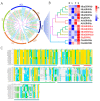A Conserved, Serine-Rich Protein Plays Opposite Roles in N-Mediated Immunity against TMV and N-Triggered Cell Death
- PMID: 36680066
- PMCID: PMC9865399
- DOI: 10.3390/v15010026
A Conserved, Serine-Rich Protein Plays Opposite Roles in N-Mediated Immunity against TMV and N-Triggered Cell Death
Abstract
Plant nucleotide-binding, leucine-rich, repeat-containing proteins (NLRs) play important roles in plant immunity. NLR expression and function are tightly regulated by multiple mechanisms. In this study, a conserved serine/arginine-rich protein (SR protein) was identified through the yeast one-hybrid screening of a tobacco cDNA library using DNA fragments from the N gene, an NLR that confers immunity to tobacco mosaic virus (TMV). This SR protein showed an interaction with a 3' genomic regulatory sequence (GRS) and has a potential role in regulating the alternative splicing of N. Thus, it was named SR regulator for N, abbreviated SR4N. Further study showed that SR4N plays a positive role in N-mediated cell death but a negative role in N protein accumulation. SR4N also promotes multiple virus replications in co-expression experiments, and this enhancement may not function through RNA silencing suppression, as it did not enhance 35S-GFP expression in co-infiltration experiments. Bioinformatic and molecular studies revealed that SR4N belongs to the SR2Z subtype of the SR protein family, which was conserved in both dicots and monocots, and its roles in repressing viral immunity and triggering cell death were also conserved. Our study revealed new roles for SR2Z family proteins in plant immunity against viruses.
Keywords: N gene; RNA silencing; SR proteins; cell death; plant immunity; tobacco mosaic virus.
Conflict of interest statement
The authors declare no conflict of interest.
Figures







Similar articles
-
A role for small RNA in regulating innate immunity during plant growth.PLoS Pathog. 2018 Jan 2;14(1):e1006756. doi: 10.1371/journal.ppat.1006756. eCollection 2018 Jan. PLoS Pathog. 2018. PMID: 29293695 Free PMC article.
-
Tobacco alpha-expansin EXPA4 plays a role in Nicotiana benthamiana defence against Tobacco mosaic virus.Planta. 2018 Feb;247(2):355-368. doi: 10.1007/s00425-017-2785-6. Epub 2017 Oct 9. Planta. 2018. PMID: 28993946
-
Cell death triggering and effector recognition by Sw-5 SD-CNL proteins from resistant and susceptible tomato isolines to Tomato spotted wilt virus.Mol Plant Pathol. 2016 Dec;17(9):1442-1454. doi: 10.1111/mpp.12439. Epub 2016 Aug 14. Mol Plant Pathol. 2016. PMID: 27271212 Free PMC article.
-
Interactions between tobacco mosaic virus and the tobacco N gene.Philos Trans R Soc Lond B Biol Sci. 1999 Mar 29;354(1383):653-8. doi: 10.1098/rstb.1999.0417. Philos Trans R Soc Lond B Biol Sci. 1999. PMID: 10212945 Free PMC article. Review.
-
Functional roles of the pepper leucine-rich repeat protein and its interactions with pathogenesis-related and hypersensitive-induced proteins in plant cell death and immunity.Planta. 2017 Sep;246(3):351-364. doi: 10.1007/s00425-017-2709-5. Epub 2017 May 15. Planta. 2017. PMID: 28508261 Review.
Cited by
-
Large Artificial microRNA Cluster Genes Confer Effective Resistance against Multiple Tomato Yellow Leaf Curl Viruses in Transgenic Tomato.Plants (Basel). 2023 May 31;12(11):2179. doi: 10.3390/plants12112179. Plants (Basel). 2023. PMID: 37299158 Free PMC article.
-
A plant-specific clade of serine/arginine-rich proteins regulates RNA splicing homeostasis and thermotolerance in tomato.Nucleic Acids Res. 2024 Oct 28;52(19):11466-11480. doi: 10.1093/nar/gkae730. Nucleic Acids Res. 2024. PMID: 39180404 Free PMC article.
-
The State of the Art of Plant Virus Research in China.Viruses. 2024 Oct 21;16(10):1639. doi: 10.3390/v16101639. Viruses. 2024. PMID: 39459971 Free PMC article.
References
-
- Blevins T., Rajeswaran R., Aregger M., Borah B.K., Schepetilnikov M., Baerlocher L., Farinelli L., Meins F., Jr., Hohn T., Pooggin M.M. Massive production of small RNAs from a non-coding region of Cauliflower mosaic virus in plant defense and viral counter-defense. Nucleic Acids Res. 2011;39:5003–5014. doi: 10.1093/nar/gkr119. - DOI - PMC - PubMed
Publication types
MeSH terms
Substances
LinkOut - more resources
Full Text Sources
Research Materials

